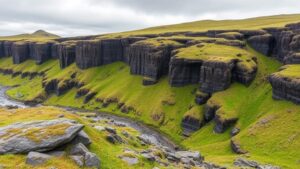Navigating dense jungles while preserving biodiversity in search of ruins.
Navigating Dense Jungles While Preserving Biodiversity in Search of Ruins
The heart of a jungle often conceals more than vibrant flora and fauna; it harbors ancient ruins that tell the stories of civilizations long gone. From the ruins of the Maya in Central America to the temples of Angkor Wat in Southeast Asia, these historical sites are treasures of cultural heritage. But, exploring these sites in dense jungles presents unique challenges, particularly in terms of environmental preservation. This article delves into the methods of navigating these lush landscapes while safeguarding biodiversity.
The Importance of Biodiversity
Biodiversity refers to the variety of life found on Earth, including the different plants, animals, and microorganisms. Its importance cannot be overstated, as it contributes to ecosystem resilience, human health, and cultural identity. For example, the Amazon Rainforest, which represents 50% of the worlds remaining rainforests, is home to one-tenth of all species on Earth, according to the World Wildlife Fund. When exploring jungles, the goal is to balance archaeological pursuits with the protection of biodiversity, ensuring that one does not come at the expense of the other.
Strategic Planning for Exploration
Before embarking on a journey into the jungle in search of ruins, careful planning is essential. This involves selecting the right time of year, understanding the terrain, and preparing for potential challenges. For example, the rainy season in the Amazon typically runs from December to May, making navigation difficult and potentially dangerous. By choosing the dry season, explorers can vastly improve their chances of success.
Choosing Sustainable Navigation Techniques
Once in the jungle, the method of navigation plays a critical role in minimizing ecological impact. Here are some sustainable techniques:
- Footpaths: Utilizing existing paths reduces the disturbance caused by clearing new trails.
- Guided Tours: Engaging local guides not only helps in navigating but also supports the local economy and fosters cultural exchange.
- Low-Impact Gear: Using lightweight and biodegradable gear reduces waste and minimizes soil compaction.
For example, in the Yucatán Peninsula, eco-tourism initiatives have made it possible for explorers to discover ancient Maya cities like Tikal, while simultaneously promoting conservation efforts and community involvement.
Preservation Practices During Excavation
When excavating ruins, respecting the surrounding ecosystem is paramount. Several practices can be adopted to ensure preservation:
- Site Surveys: Conducting thorough surveys before excavation helps understand the sites ecological significance.
- Minimal Disturbance: Using non-invasive techniques, such as ground-penetrating radar, allows researchers to identify important features without disturbing the soil.
- Rehabilitation Efforts: After excavation, groups are encouraged to rehabilitate the site with native plant species to restore biodiversity.
In 2016, a team of archaeologists discovered a series of ancient temples in the tropical forests of Honduras. r commitment to ecological sensitivity resulted in positive collaborations with local conservation organizations to protect endangered species in the area.
The Role of Technology in Balancing Exploration and Conservation
Technology plays an increasingly critical role in ensuring that the quest for knowledge does not jeopardize the environment. Geographic Information Systems (GIS) and drone technology allow researchers to map and monitor untouched regions effectively. For example, utilizing drones for aerial surveys in dense regions can help locate potential archaeological sites without the need for extensive ground clearing. This not only speeds up the research process but also protects the habitat.
Community Involvement and Education
Involving local communities in exploration efforts ensures that they benefit from the preservation of their cultural heritage. In the Amazon basin, collaborative projects between archaeologists and indigenous groups have led to the discovery and protection of ancient sites. Educating these communities about the significance of their history encourages a sense of stewardship toward their environment, further enhancing biodiversity conservation initiatives.
Conclusion: Moving Forward with Care
Exploring the dense jungles of the world to uncover ancient ruins is a thrilling pursuit, but it carries a significant responsibility. Balancing archaeological exploration and biodiversity preservation is not only essential for the environment but also for cultural heritage. By implementing sustainable practices, leveraging technology, and fostering community engagement, adventurers can ensure that future generations inherit a world rich in both history and biodiversity. Moving forward, let each journey into the jungle be a testament to our commitment to protecting the delicate ecosystems we cherish.



